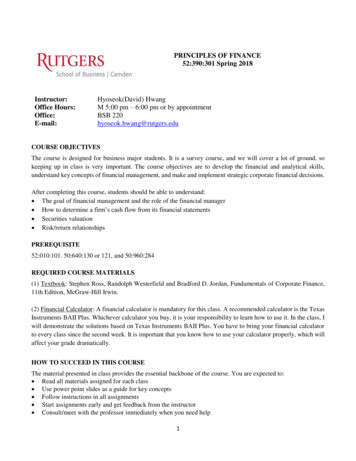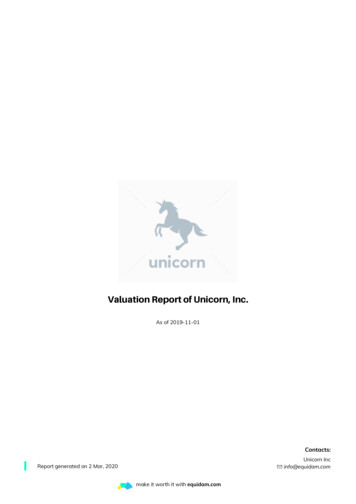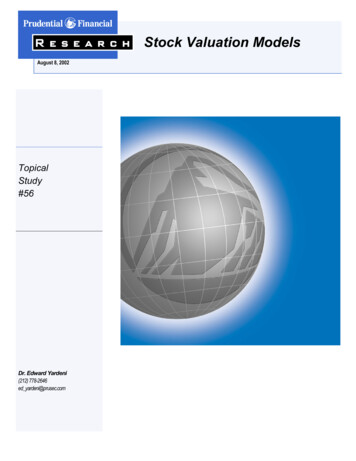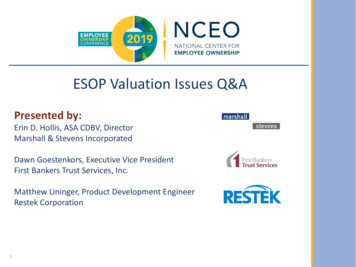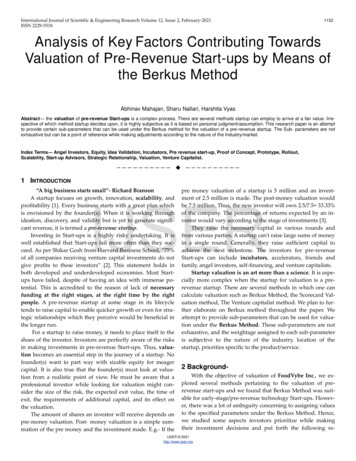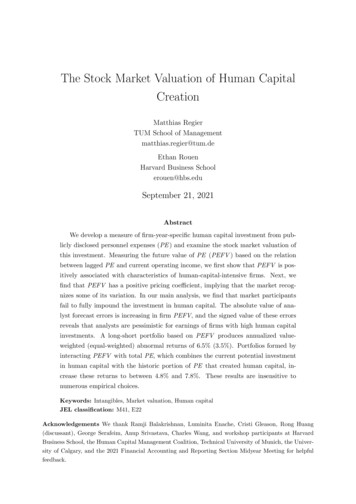
Transcription
The Stock Market Valuation of Human CapitalCreationMatthias RegierTUM School of Managementmatthias.regier@tum.deEthan RouenHarvard Business Schoolerouen@hbs.eduSeptember 21, 2021AbstractWe develop a measure of firm-year-specific human capital investment from publicly disclosed personnel expenses (PE ) and examine the stock market valuation ofthis investment. Measuring the future value of PE (PEFV ) based on the relationbetween lagged PE and current operating income, we first show that PEFV is positively associated with characteristics of human-capital-intensive firms. Next, wefind that PEFV has a positive pricing coefficient, implying that the market recognizes some of its variation. In our main analysis, we find that market participantsfail to fully impound the investment in human capital. The absolute value of analyst forecast errors is increasing in firm PEFV, and the signed value of these errorsreveals that analysts are pessimistic for earnings of firms with high human capitalinvestments. A long-short portfolio based on PEFV produces annualized valueweighted (equal-weighted) abnormal returns of 6.5% (3.5%). Portfolios formed byinteracting PEFV with total PE, which combines the current potential investmentin human capital with the historic portion of PE that created human capital, increase these returns to between 4.8% and 7.8%. These results are insensitive tonumerous empirical choices.Keywords: Intangibles, Market valuation, Human capitalJEL classification: M41, E22Acknowledgements We thank Ramji Balakrishnan, Luminita Enache, Cristi Gleason, Rong Huang(discussant), George Serafeim, Anup Srivastava, Charles Wang, and workshop participants at HarvardBusiness School, the Human Capital Management Coalition, Technical University of Munich, the University of Calgary, and the 2021 Financial Accounting and Reporting Section Midyear Meeting for helpfulfeedback.
1IntroductionAccounting rules require that most expenditures related to employees be treated as costsand expensed as incurred. The reason for this treatment is that unlike with assets,firms do not have control over their employees (i.e., employees are not forced to remainemployed by the firm). Still, costs related to employees likely consist of two components,the immediate expense that ensures that employees contribute to maintaining currentbusiness operations, and the investment that encourages employees to improve in theirroles and grow the firm. This latter component, which can take various forms ranging fromincentive-based compensation to on-the-job training, gives rise to the trope illustrated byXerox CEO Anne Mulcahy in 2003 that “Employees are a company’s greatest asset.”1This paper seeks to better understand the information contained in employee expensedisclosures, specifically the “Personnel Expense” (PE ) line item that firms are required todisclose under International Financial Reporting Standards (IFRS).2 To do so, we developa methodology to identify at the firm-year level how successful a firm is at investing inpersonnel (i.e., the human capital investment). Our main analysis examines whethermarket participants recognize and appropriately value this component of PE, what werefer to as the future value of PE, or PEFV.While measuring human capital creation is complex and imperfect, it is growing increasingly important. In a 2000 paper, Luigi Zingales wrote, “The wave of initial publicofferings of purely human capital firms. is changing the very nature of the firm” (Zingales, 2000). If anything, the change has accelerated since the time of that writing. Asshown in Figure 1, from 1992 to 2018, capital expenditures as a percentage of total salesremained relatively flat at about 10%. On the other hand, PE almost doubled during that1This quotation is attributed to a speech Mulcahy made in May at the Doral Arrowwood Resort inRye Brook, N.Y.2Throughout the paper we use the terms “personnel expense” or “personnel expenditure” to referto the Thomson Reuters Datastream item Personnel expense for all employees and officers (mnemonicWC01084). This item mostly relates to personnel expenditures that are expensed as incurred. As definedin IAS 19, the item includes, among others, the costs for hiring, wages, salaries and bonuses, socialsecurity and insurance costs, perquisites like catering and work wear, and post-termination benefits.While some firms disaggregate expenses by nature so that PE is visible on the income statement, mostfirms disaggregate by function and provide total PE somewhere in the notes. In the latter case, PEis typically divided among firms’ cost of goods sold, selling, general and administrative expense, andresearch and development expense.1
time. By 2018, PE consumed more than one third of all of the average firm’s revenues inour large sample of publicly traded European firms reporting under IFRS.The growing importance of human capital to firms’ profit generating abilities, combined with the paucity of disclosures related to employees and investment in the workforce,potentially creates an information gap that distorts valuation of the firm (Zingales, 2000).While IFRS requires firms to disclose PE, under U.S. Generally Accepted AccountingPrinciples (GAAP), firms are required to disclose only the total number of employeesand, since 2018, the salary of the median employee, a measure that lacks relation tofuture performance (Rouen, 2020).Given these limited disclosures, investors face informational challenges when attempting to recognize variation in firms’ abilities to effectively invest in intangible assets broadlyand generate human capital specifically. Prior research investigates whether markets realize the future value generated by firms’ expenditure on input resources such as researchand development (R&D) (e.g., Eberhart et al., 2004; Lev and Sougiannis, 1996), advertising (Chan et al., 2001), and selling, general, and administrative (SG&A) (Bankeret al., 2019). Moreover, accounting and finance scholars have shown the need for markets’recognition of firms’ human capital quality (e.g., Ballester et al., 2002; Edmans, 2011;Lee et al., 2018; Pantzalis and Park, 2009). To provide a better understanding of humancapital investments, we analyze the stock market valuation of PE, the expenditure of theinput resource that is most intuitively related to the ability to create human capital.Empirically, it is unclear whether and how PE should be associated with the futurevalue of the firm. To a large extent, PE consists of the wages paid to workers in the periodin which that work is done. If intangible human capital investments are absent from (oran insignificant component of) PE, then there should be little relation between PE andfuture returns given that the resource is consumed in the period in which it is reported.Alternatively, Bertrand and Mullainathan (2003) suggests that abnormally high PE maybe due to a failure of governance, with managers paying more than is required to reducetheir obligations at a cost to shareholders, meaning that higher PE may be associatedwith lower returns. Lastly, a portion of a firm’s PE may support current operations as a2
cost, while another significant portion may constitute a personnel investment to develophuman capital for future income (Flamholtz, 1971).Prior literature has provided suggestive evidence of the usefulness of PE for valuationpurposes. While expenditures associated with human capital investments are not recognized on firms’ balance sheets, total PE, as reported on the income statement, has beenshown to increase earnings predictability and value relevance (Schiemann and Guenther,2013; Rouen, 2019). If a meaningful portion of PE represents investment in human capital, and human capital accounts for a relevant portion of firms’ market values, then theseinvestments, when properly measured, should be predictive of future returns (Ballesteret al., 2002). Moreover, PE clearly supports employee satisfaction, which correlates withabnormal returns (Edmans, 2011).Another potential reason why PE could be value relevant relates to risk. Humancapital creation in general and high PE in particular increase firm risk, given that theseinvestments, much like R&D, have uncertain outcomes, and, in a way, may have evengreater uncertainty than research investments. Similar to research, investing in employeescomes with the risk that the investment might fail due to a misunderstanding of theemployees or skill in which the firm invests. In addition, because firms do not own theiremployees, human capital is reduced when employees leave the firm (Lev and Schwartz,1971). High PE may also be difficult or costly to adjust in the short run, leading to highlabor leverage and increasing firms’ equity risk (Donangelo et al., 2019; Rosett, 2003),which could lead markets to demand a risk premium. For example, Donangelo et al.(2019) finds that firms with high labor bills have higher expected returns, in part becausethese firms’ operating profits are more sensitive to economic shocks given the stickinessof employee costs.Our approach differs from prior studies in that we acknowledge that PE can impactfuture earnings (Schiemann and Guenther, 2013), and that there are firms where PEconstitutes a substantial human capital investment (Ballester et al., 2002), but we capturecross-industry and cross-firm variation in the ability to create future value from PE. Thisstrategy allows us to explore whether and when the stock market realizes the future value3
created by PE.This paper takes several steps to further the nascent literature on the relations amongemployee expenditures, human capital creation, and firm performance. Adapting methodologies to extract from an expenditure the intangible assets created by that expenditure,we create a proxy for the component of PE consisting of investments in human capitalby identifying the relation between prior period PE and current firm performance (e.g.,Banker et al., 2019; Chen et al., 2012; Huson et al., 2012; Lev and Sougiannis, 1996). Fora large sample of firms across 30 European countries, in our main analyses we begin byregressing at the industry level current operating income on several years of lagged PEto identify the optimal lag structure for each industry in terms of the number of yearsin which PE influences income after that PE is initially incurred.3 In some industries,as many as three years of lagged PE are significantly positively associated with currentoperating income (e.g., manufacturing) while in other industries, prior PE has no relationto current performance (e.g., chemicals). Next, we rerun these regressions at the firm-yearlevel using the industry-determined lag structure. Summing the coefficients on prior PEfrom these regressions provides a firm-year estimate of the PE future value (PEFV ), ourmain variable of interest.We begin our empirical analysis by validating our proxy for human capital investment(PEFV ), examining whether PEFV is associated with firm characteristics that are likelyto be related to the importance of human capital creation. We find that firms with higherPEFV are smaller, have higher market-to-book ratios, have fewer tangible assets, andprovide more training days to employees. That growth and less capital-intensive firmshave higher PEFV provides us with confidence in this measure as an effective proxy forinvestments in human capital.Next, we examine the association between PEFV and contemporaneous stock price.While the relation between total PE and stock price is negative and significant, therelation between PEFV and contemporaneous price is positive and significant. Thisresult suggests that the stock market, to some extent, differentiates between the current3The optimal lag structure is determined by identifying the number of prior years in which PE has astatistically significant relation with current operating income.4
operating expense component of PE and the future value of PE, which is treated as anintangible asset. In other words, the stock market recognizes at least some of firms’ humancapital creation at the time when the investment in that human capital materializes (i.e.,when the prior period investment is consumed). This result is robust to a battery ofdifferent controls and specifications. While PEFV is measured with error, these resultsprovide further evidence that PEFV captures, in part, the investment we are attemptingto measure.Our main analyses examine whether market participants fully recognize this futurevalue of the intangible asset included in PE. To do so, we analyze the predictive powerof PEFV for sell-side analysts’ earnings forecast errors and firms’ future stock returns.First, we find a significant positive relation between the magnitude of PEFV and forecasterrors, as well as absolute forecast errors. These results suggest that, not only do analystsfail to incorporate into their forecasts the full value of the investment component of PE,but that they overweight the expense component, resulting in pessimistic forecasts.Next, we build two types of portfolios based on PEFV. First, we sort firms into portfolios based solely on PEFV. Second, we sort firms into portfolios based on the combinationof PEFV and PE scaled by total assets, PEFV*PE/TA. This second set of analyses provides insights into both the investment in human capital and the opportunity to make thatinvestment, based on the total amount spent on employees in the current period. Theseportfolio analyses produce statistically and economically meaningful results. A valueweighted (equal-weighted) long-short investment strategy based on the level of PEFVreturns annualized abnormal returns of 6.5% (3.5%), while a strategy that divides firmsinto portfolios based on PEFV*PE/TA results in abnormal annualized returns of 7.8%(4.8%) in the subsequent year. These results, which are statistically and economicallysignificant, suggest that the market fails to fully impound the human capital developmentembedded in PE, as well as the opportunity to make that investment. The results arealso robust to numerous alternative specifications, including assigning portfolios basedon industry, excluding firms from countries with illiquid currencies, using different factormodels, and requiring identical lag structures across all firms when calculating PEFV.5
The results also remain unchanged when conducting Fama-MacBeth cross-sectional regressions (Fama and MacBeth, 1973). Lastly, we find that the abnormal portfolio returnsdecrease monotonically over time, with statistically significant value-weighted returns of5.1% in the second year after portfolio formation, and insignificant returns of 3.1% in thethird year.Given that PEFV likely fails to include some investment in human capital that did notmaterialize, we also explore whether the results are robust to an alternative measure ofhuman capital investment that is likely to capture these investments. We adapt Enacheand Srivastava (2017) in creating an alternative measure of human capital investmentand find that portfolios formed using this measure continue to produce abnormal returns.Still, we acknowledge that our proxy for human capital investment is measured with error.Total personnel expense is an admittedly crude starting point to approximate measures ofhuman capital. Included in PE is not only wages, social security expenses, and trainingcosts, but also costs like uniforms, firm-hosted daycare centers, and meals. Exacerbatingthe challenge is that firms in our sample do not disaggregate this significant operatingexpense in any meaningful way. Therefore, the findings in this paper should serve asevidence that disclosures related to human capital are value relevant and can providea basis for how firms and regulators can improve employee-related disclosures as theybecome increasingly relevant in the knowledge economy.This paper makes several contributions to the literature. First, we provide evidenceof the value of human-capital-related disclosures to market participants. There is littleevidence of the relation between employee expense and future firm performance, and weare the first to develop an effective way to extract the future value of the expenditurefrom the total expense.4 We show not only that there is significant variation in the abilityof firms to generate future value from their investment in employees through PE, but alsothat employee expenses are relevant for future performance and mispriced by the market.Second, we contribute to two ongoing regulatory debates. Our results are informativeto U.S. investors and the Securities and Exchange Commission (SEC), which recently4Papers that examine labor expenses’ relation to firm market value are Schiemann and Guenther(2013) and Ballester et al. (2002).6
passed an amendment to its Regulation S-K requiring firms to provide a description ofthe importance of their human capital resources to the underlying business. The currentrequirement gives firms wide latitude in terms of what they define as material humancapital information, and large investors continue to engage regulators on which humancapital disclosures are value relevant (Human-Capital-Management-Coalition, 2019; Maurer, 2021). Our results provide guidance on the disclosures that are relevant to investors.In addition, the convergence project between the Financial Accounting Standards Boardand the International Accounting Standards Board has discussed whether it is more informative to disaggregate costs by their function or by their nature, including a debate asto whether disclosure of nature of expense items like PE should also be mandatory underby-function systems.5 Our result that the market does not fully recognize the humancapital creation implicit in PE supports the need to consider changes in the accountingfor input resource expenditures (e.g., Enache and Srivastava, 2017; Lev, 2019).Finally, we add the nature of expense perspective to the stream of research on the stockmarket valuation of intangible assets. Prior literature shows that the market misvaluesfunctional expenses like R&D (Chan et al., 1990; Eberhart et al., 2004; Lev and Sougiannis,1996), advertising (Chan et al., 2001), and SG&A (Banker et al., 2019). Until now, thisresearch has paid little attention to the nature of the expense, broadly, and PE specifically.Relatedly, we expand the emerging literature on the impact of firms’ ability to generatefuture value from input resource expenditures. For instance, scholars have analyzed theeffects of executive compensation and cost decisions on market valuations (Banker et al.,2011; Chen et al., 2012; Huson et al., 2012; Banker et al., 2019). These studies limit theirevidence to a subset of employees and rely only on evidence for U.S. firms. We examine anintuitive, widely reported input resource that can be analyzed in an IFRS cross-countrysetting.The remainder of this paper is organized as follows. Section 2 describes the data usedand the research design. Section 3 reports descriptive statistics, and Section 4 describesthe main empirical results and robustness analyses. Section 5 concludes the paper.5We refer to the Financial Accounting Standards Board and International Accounting Standards BoardJoint Meeting on Primary Financial Statements in June 2018.7
2Research design, data, and variable measurement2.1Research setting and sample selectionTo test whether the market realizes firms’ human capital creation from PE, we exploit themandate to disclose PE for firms listed in European Union (EU) countries. Firms listedon an EU regulated market must report according to IFRS, which requires disclosure ofPE. We include in our sample the current 27 members of the EU as well as the UnitedKingdom, which left the EU in early 2020. We further add Norway and Switzerland (e.g.,Armstrong et al., 2010; Byard et al., 2011). We therefore begin the sample selection withall firms listed in any of these 30 countries.Panel A of Table 1 shows the sample selection procedure. We consider 11,569 nonfinancial and non-utilities firms (e.g., He and Narayanamoorthy, 2020) that were active atsome point in time during the period 1991 to 2018. For those firms, we obtain ThomsonReuters Datastream data for 124,507 firm-years from 1992 to 2018, which begins one yearlater since we use average total assets (TA) to deflate the financial statement variables.6We remove firm-years with missing financial statement items (TA, PE, operating income(OI ), and depreciation & amortization), stock-related data (share price and market capitalization), and number of employees. We consider only firm-years with at least 20( 0.5) million in total assets (personnel expenses). We require at least five firms in everySIC-4-industry-year (e.g., Banker et al., 2011; Lev and Sougiannis, 1996).7 This procedure results in an initial sample of 64,579 firm-years. Based on this sample, we winsorizethe financial statement ratio variables yearly at the 1% and 99% level (Banker et al.,2019). We then remove firm-years where less than four years of lagged data are available,which leaves a sample period from 1996 to 2018. Removing FF12-industry-years withless than 15 firms gives the sample of 33,989 firm-years used to obtain the optimal lag6Many countries required the disclosure of PE prior to the EU’s IFRS adoption in 2005. We neitherobserve a kink in data availability around 2005, nor in any other year. We therefore begin our sample in1992, when these data become widely available.7This requirement is needed for the instrumental variable approach that we explain in the next subsection. If there are less than five firms available in the SIC-4-industry-year, we pool the firms on theSIC-3 level, where we again require at least five firms in the industry-year.8
structure per FF12-industry.8 Of that sample, 21,708 firm-years have sufficient laggeddata to allow the firm-year-specific calculation of the human capital investment (i.e., thepersonnel expenditure future value, PEFV ). In our main analyses, we focus on the firmsfrom industries with at least one lag and positive PEFV estimates. The earliest yearwhere a calculation with one lag is possible is 1998. Our final sample contains 11,009positive PEFV firm-years from 1998 to 2018.Panel B of Table 1 shows the distribution of firm-years among countries and FF12industries for the 33,989 firm-years used to obtain the optimal lag structure per industryand for the final sample of 11,009 positive PEFV firm-years. United Kingdom firmsaccount for the largest portion of firm-years, followed by French and German firms. Therelative weight of the sampled countries is comparable with other studies on EU firms(e.g., Armstrong et al., 2010; Byard et al., 2011; Christensen et al., 2013), implying thatthe required data availability does not distort the sample such that generalization of theresults to the universe of EU firms is not warranted. Firms in the Manufacturing, BusinessEquipment and residual category Other industries account for the largest portion of firmyears. The sample reduction induced by focusing on the firm-years with positive PEFV(i.e., from N to Nf inal ) distorts neither the country nor the industry distribution.2.2Measurement of personnel expenditure future valueWe begin our analysis of the human capital investment implicit in PE by estimating thelong-term effect of lagged PE on current operating income following a two-step procedure.First, we obtain the optimal PE lag structure for the relation between operating incomeand PE for each FF12-industry using the following equation:OI/T Ai,t α nXβk (P E/T Apredicted )i,t k γlog(#E)i,t ηt εi,t .(1)k 0Equation (1) is adapted from earlier methodological approaches to be currency neutral(e.g., Banker et al., 2011; Lev and Sougiannis, 1996). We estimate equation (1) for each8We use the Fama and French industry classification as it provides intuitive and consistent categoriesto assess the industry-specific lag structure. At the same time, we rely on the SIC categorization forthose parts of our methodology that require a numerical disaggregation.9
FF12-industry with different numbers of lags (different n).9 OI/T Ai,t is operating incomebefore depreciation & amortization and PE (e.g., Banker et al., 2019) deflated by averageTA. (P E/T Apredicted )i,t k is the predicted value using an instrumental variables approachfor the deflated PE of year t-k as follows:Following Lev and Sougiannis (1996) and Banker et al. (2019), we use industry-yearPE as an instrument in equation (1) to address a potential simultaneity problem whena shock to the residual affects both the dependent (OI ) and the independent variable(PE ).10 For each firm-year observation, we calculate the average PE of all other firmsin the SIC-4-industry ((P E/T ASIC4 i )i,t ). We assume that firm idiosyncratic shocksdo not affect industry-year PE.11 At the same time, industry-year PE should be highlycorrelated with firm-year PE. For each year and SIC-2-industry, we regress P E/T Ai,t onthe industry-year PE :P E/T Ai,t α β(P E/T ASIC4 i )i,t εi,t(2)We obtain the predicted value (P E/T Apredicted )i,t from equation (2) and use it in theindustry-level and firm-year-level estimations of equation (1).In equation (1), we include the natural logarithm of the number of employees to account for firm size as there may be scale effects when analyzing how intangible investmentsare reflected in future income (Ciftci and Cready, 2011) and also include year indicators(ηt ).12 For each FF12-industry, we determine the lag structure with all positive and statistically significant (at the one-sided 10% level) coefficients and the most explanatory9Banker et al. (2019) consider models ranging from zero to seven years, Huson et al. (2012) considerup to five lagged years in their industry-specific analyses of the future value of SG&A. It appears unlikelythat rather old human capital is still systematically relevant for operating income. Moreover, Ballesteret al. (2002) find that human capital assets depreciate, on average, over three years. Thus, we considermodels ranging from zero to four lags of PE in the industry-specific analysis.10For example, demand for a firm’s products may increase due to some exogenous shock. This couldlead to both an increase in OI and an increase in the returns to input resource expenditure like PE,which would in turn lead to an increase in PE. PE could therefore no longer be treated as an exogenousvariable.11The firms in a SIC-4-industry may still be subject to a SIC-4-industry idiosyncratic shock.12Banker et al. (2019) add current R&D and advertising expenditures to the model when estimatingthe future value of SG&A. PE already contains the personnel expenses included in SG&A, R&D andadvertising, so we do not add any of the functional expenditure items to the model.10
power.13Second, we fix the optimal lag structure from the first step for all firms of a givenindustry. We next rerun equation (1) at the firm-year level.14 For each firm-year, we usecurrent and historical data of that firm, compatible with an investor’s information set ata given point in time. We only run the regression in firm-years where there is sufficienthistorical data to obtain all coefficients of the respective model.15 We use rolling windowsof historical years in the firm-specific regressions using the number of lags determinedat the industry level in the first step. P EF Vi,t is calculated as the (discounted) sumof the firm-year-specific coefficients on past PE (P EF Vi,t Pnk 1βk /(1.1)k ) and servesas the proxy for human capital investment.16 The intuition is that it reflects the totaleffect of a currency unit of spending of current PE on future OI. To allay concerns aboutmeasurement error, we show in Section 4.4.4 that our main results are robust to analternative strategy for measuring human capital investment.2.3Optimal lag structureThe first step of the two-step-procedure to estimate PEFV is to define the optimal lagstructure for each industry by estimating equation (1) at the industry level. To gaininitial insight on the impact of past PE on current OI, we show results for estimatingequation (1) across industries including FF12-industry indicators in Panel A of Table 2.We show results for structures of one to four lags. The table shows that past streams ofPE with different lag structures have significantly positive effects on current OI. In eachof the four models, the discounted coefficients on past PE add up to between 0.355 and0.417. It thus appears that a substantial portion of PE is a value-creating investment on13We assess the explanatory power according to the Akaike Information Criterion (AIC), the SchwartzBayesian Criterion (SBC), and adjusted R2 . We thereby regard a model to have the highest explanatorypower when both AIC and SBC are lowest for this model. If the AIC and SBC criterion leave two differentmodels, the model with the higher adjusted R2 is chosen.14We do not include the proxy for firm size when running the regressions on the firm-year level. Thoseregressions also do not provide the degrees of freedom to include year indicators.15For instance, for a firm with full data coverage from 1992 to 2018, 1996 is the first year where dataof the four preceding years is available. If the firm operates in a FF12-industry where we identify threelags to have the highest explanatory power, then the firm-year-specific regression for this firm has fivecoefficients (α and β0 to β3 ). This regression is possible from year 2000 onward.16We use the same interest rate of ten percent to discount the coefficients as earlier papers (e.g., Bankeret al., 2011, 2019). The results are not sensitive to the choice of the interest rate.11
average.Next, we obtain the optimal lag structure per industry. We run equation (1) industryby-industry. Panel B of Table 2 provides the coefficient estimates for the lag structure withall
Matthias Regier TUM School of Management matthias.regier@tum.de Ethan Rouen Harvard Business School erouen@hbs.edu September 21, 2021 Abstract We develop a measure of rm-year-speci c human capital investment from pub-licly disclosed personnel expenses (PE) and examine the stock market valuation of this investment.


